Driver Detected a Controller Error on \Device\Ide\IdePort1
The ‘Driver detected a controller error on \Device\Ide\IdePort1‘ error is typically discovered using Event Viewer after the user experiences general system instability. In most cases, this error is discovered after frequent application crashes.

There are several different causes that might force the Event Viewer to create multiple entries with this error. A drive that’s in the process of going bad is the most frequent scenario, but sector errors, bad sectors descriptors, and misaligned timestamps can also cause this issue.
When investigating this issue, you should also consider inspecting your SATA / ATI cables for loose pins and bad cables. Only after you eliminate potential hardware culprits, you should start troubleshooting for software related causes such as a corrupted or outdated IDE / ATA / ATAPI controller and system file corruption.
How to Fix ‘The driver detected a controller error on \Device\Ide\IdePort1’ issues?
1. Inspect the SMART Status of your HDD
Before exploring other repair strategies, let’s make sure that the issue is not being caused by an underlying HDD issue. By using a SMART (Self-Monitoring, Analysis, and Reporting Technology) log/information tool on your HDD, you’ll be able to determine if a hardware issue is causing the problem.
If your HDD is dying, none of the other fixes featured below will allow you to fix the issue.
There are a lot of SMART will get the job done, but not all of them are free. One popular free alternative that will get the job done is CrystalDiskInfo. This tool will allow you to view your hard disk’s SMART data and determine if your HDD is dying or not.
Here’s a quick guide that will help you determine the status of your HDD via CrystalDiskInfo:
- Open your default browser and navigate to this link (here). Inside, click on the Download button, then click on the INSTALLER version associated with the Standard Edition and wait for the download to complete.
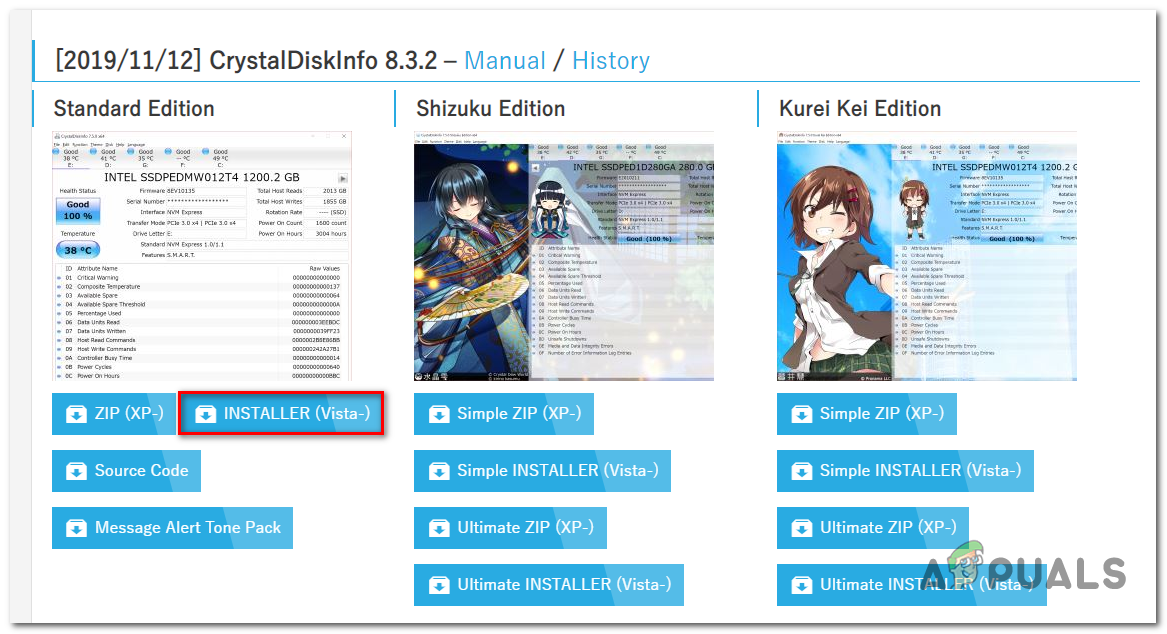
Downloading the Standard version of CrystalDiskInfo - Once the download is complete, double-click on the installation executable and click Yes at the UAC (User Account Control) prompt. Then, accept the License Agreement and follow the on-screen prompts to complete the installation.
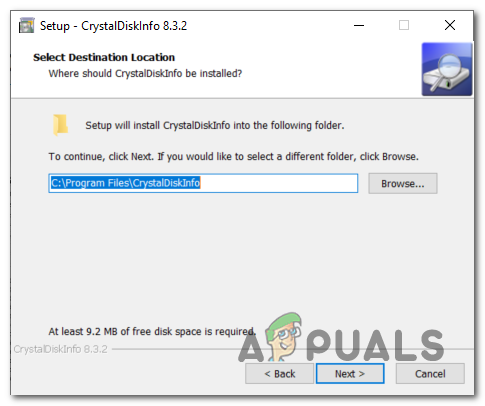
Installing the Crystal Disk Info utility Note: The installation executable is not important, so feel free to install it wherever you want.
- Once the installation is complete. open the Crystal Disk Info utility.
- With the Crystal Disk Info utility open, look at the Health Status. If the status is Good, it’s clear that the error is not occurring due to an HDD hardware issue. But if the status is Bad or Caution, your HDD drive is near death and you should back up your drive and look for a replacement.

Crystal Disk Info Note: If you have multiple drives, you can change between then from the tab directly under the ribbon bar at the top.
In case the scan determines that your HDD has no issues, you can move forward to the next fixes and one of them should allow you to resolve the issue.
2. Run a CHKDSK scan
If the investigation above has revealed that your HDD is healthy, chances are the issue is being facilitated by one or more bad sectors that are inaccessible by your OS. Because of this, your system might end up throwing ‘driver detected a controller error on \Device\Ide\IdePort1‘ errors in the background (inside Event Viewer).
This build-in utility will scan the integrity of your HDD sectors and look for bad sectors, metadata and logical file errors that might facilitate the apparition of this issue. In the event that an issue is found, the utility will try to use healthy sectors to replace bad ones.
Keep in mind that a corrupted volume master file table, a bad sector descriptor or a misaligned time stamp might also trigger this ‘driver detected a controller error on \Device\Ide\IdePort1‘ issue.
Here’s a quick guide on running the CHKDSK scan:
- Open up a Run dialog box by pressing Windows key + R. Next, type ‘cmd’ and press Enter, then press Ctrl + Shift + Enter to open up an elevated Command Prompt. When you see the UAC (User Account Control), click Yes to grant administrative privileges.

Running the Command Prompt - Once you’re inside the elevated CMD terminal, type the following command and press Enter to initiate a CHKDSK scan:
chkdsk /f
- Wait patiently until the operation is complete, then reboot your computer. At the next startup sequence, see if the problem is resolved by checking your Event Viewer for new ‘driver detected a controller error on \Device\Ide\IdePort1‘ errors.
If the same problem is still occurring, move down to the next potential fix below.
3. Replace the SATA cable (if applicable)
As several affected users have confirmed, this particular issue can also occur due to a faulty SATA cable or a faulty SATA port. A connection problem can very easily cause ‘driver detected a controller error on \Device\Ide\IdePort1‘ errors after each interruption.
If it’s possible, connect the HDD on a different computer oat least use a different SATA port and cable if you don’t have a second machine to do some testing on.

Note: Do not confuse the data SATA cable with the power equivalent.
In case the issue stops occurring when you use a different port with the same SATA cable, you should take your motherboard to an IT technician to investigate for loose pins.
On the other hand, if the issue no longer occurs when you use a different SATA cable, a bad cable is most likely your culprit.
In case these latest investigations didn’t allow to fix the ‘driver detected a controller error on \Device\Ide\IdePort1‘ issue, move down to the next potential fix below.
4. Update the IDE ATA/ATAPI controller (if applicable)
If you’re using a legacy HDD, this problem can also occur due to an outdated or corrupted IDE ATA / ATAPI controller. Several affected users that struggled with the same error have confirmed that the issue was resolved after they used Device Manager to update the driver version of the IDE controller and restarted their computer.
Here’s a quick guide on doing this:
Note: You should be able to follow the steps below regardless of your Windows version (as long as you’re using a legacy HDD)
- Press Windows key + R to open up a Run dialog box. Next, type ‘devmgmt.msc‘ inside the text box, then press Enter to open up Device Manager.
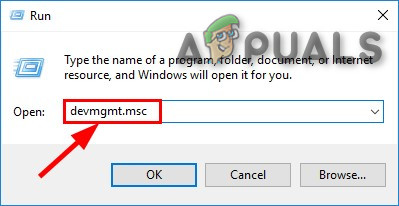
Run devmgmt.msc Note: If you’re prompted by the UAC (User Account Control), click Yes to grant administrative privileges.
- Once you’re inside Device Manager, scroll down through the list of installed devices and expand the drop-down menu associated with IDE ATA/ATAPI controllers.
- Next, right-click on your IDE / SATA / AHCI controller and chose Update driver from the newly appeared context menu.
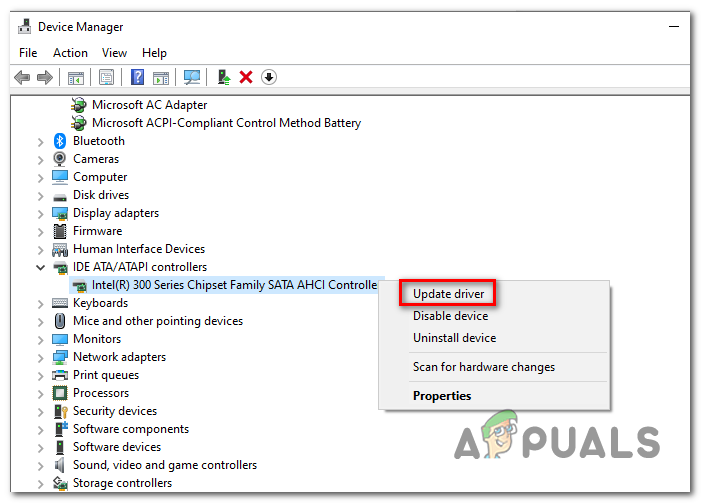
Updating the IDE ATA/ATAPI controllers - Once you’re inside the update menu of your IDE ATA/ATAPI controller, click on Search automatically for updated driver software and wait for the scan to complete.

Searching automatically for newer driver software - If a newer version is found, follow the on-screen instructions to complete the driver installation.
- Restart your computer and see if the problem is resolved once the next startup is complete.
If you’re still seeing new entries with the ‘driver detected a controller error on \Device\Ide\IdePort1‘ error, move down to the next fix below.
5. Use System Restore
If you only started seeing this behavior recently, it’s possible that a recent software change ends up causing the ‘driver detected a controller error on \Device\Ide\IdePort1‘ error. If the problem has surfaced due to a 3rd party service or process but you don’t know exactly which one, the easiest way to resolve the issue is by using the System Restore utility.
By leveraging a previously created restore snapshot, you can return your machine to a healthy state in which the scenario that’s currently causing the issue isn’t present.
Here’s a quick guide using the System Restore utility in order to fix the ‘driver detected a controller error on \Device\Ide\IdePort1‘ error:
- Open up a Run dialog box by pressing Windows key + R. Next, type ‘rstrui’ and press Enter to open up the System Restore wizard.

Opening the System Restore wizard via Run bo - Once you’re inside the System Restore wizard, press Next at the initial screen.

Getting past the initial screen of System Restore - Once you get to the next screen, start by checking the box associated with Show more restore points. Next, look at the dates and select a restore point that is dated before you first started to deal with this particular error. With the appropriate restore point selected, click Next to advance to the next menu.

Restoring your system to a previous point in time Note: Keep in mind that once you enforce your an earlier restore point, every change that was made after that point will also be lost. This means that any app installation, driver update and anything else will also be lost.
- Once you get this far, click on Finish and then click Yes at the confirmation prompt to start the restoring process. Your computer will then restart and the older state will be enforced at the next system startup.
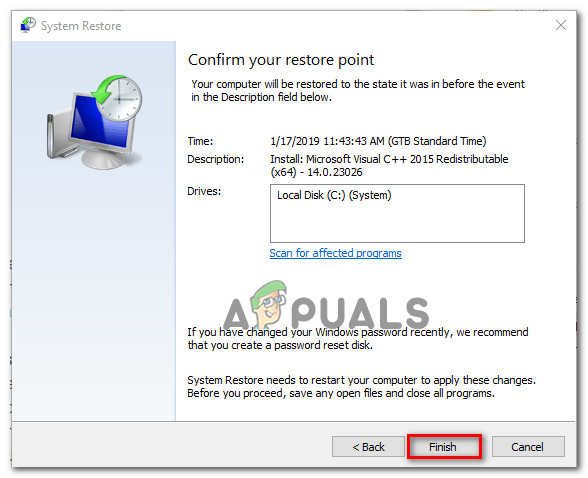
Starting the System Restore process
If you weren’t able to find an appropriate restore snapshot or this procedure didn’t resolve the issue, move down to the final method below.
6. Perform a Repair install
If none of the methods below have allowed you to fix the issue, there’s a high chance that you will not be able to fix the issue unless you manage to refresh every Windows component and every booting-related process.
This can be achieved via a clean install, but this means that you will likely lose all your personal data unless you take the time to back up your data in advance.
A more focused approach is to use a repair install (in-place upgrade). As opposed to a clean install, this operation will allow you to refresh every Windows component while keeping every bit of personal data including apps, games, personal media and even a limited selection of user preferences.




